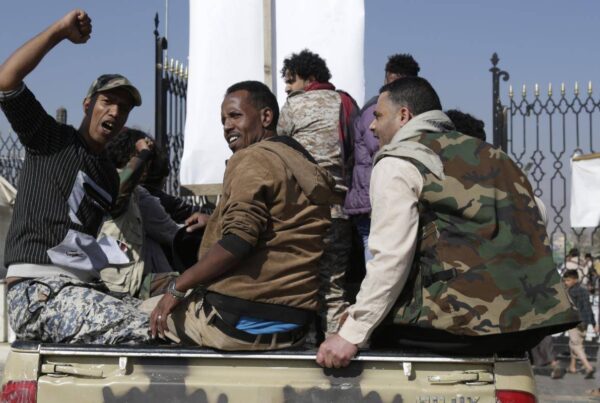As violence continues in Yemen, old regional and geographical fault lines are opening up again, undermining Yemen’s unity without offering any realistic alternative to the current borders.
As the Saudi-led international coalition continues its air strikes in Yemen, targeting the Iranian-backed group of Zaidi Shia Islamists known as the Houthis and forces loyal to the country’s former president Ali Abdullah Saleh, there seems to be no end in sight to the war. Houthi and pro-Saleh forces are in fact striking back inside Saudi territory, even claiming to have struck the Khamis Mushait air base in southern Saudi Arabia with Scud missiles.
Yemen is being torn apart by foreign intervention, competing militias, and economic breakdown. Old regional and geographical fault lines are opening up again, undermining Yemen’s unity without offering any realistic alternative to the current borders.
A History of South Yemeni Separatism
Historically, the main geographical divide in Yemen has been between its north and south. The country only recently unified, with North Yemen and South Yemen having previously been separate nations.
Beginning in 1978, North Yemen was ruled by Saleh along populist and Arab nationalist lines. By contrast, South Yemen was the Arab world’s only Communist state. Even though both governments officially labored to unite Yemen into a single nation, relations were tense and border skirmishes common. It was not until the collapse of the Soviet Union brought South Yemen to the brink of economic ruin that the rivalry could be transcended.
In 1990, the two countries crafted a unification agreement as part of a deal between their respective leaders, Saleh and Ali Salem al-Beidh. While the agreement enjoyed broad support at the time, it was hastily improvised and, at one-and-a-half-pages, shorter than a marriage contract.
After unification, some former southerners complained that the union favored the north, which had a population nearly three times as large. Northern forces accordingly dominated the 1993 parliamentary elections—the first multiparty elections on the Arabian Peninsula. In 1994, a South Yemeni attempt at secession was put down by northern army forces and Islamist militias, aided by certain groups in the south. This led to the further entrenchment of Saleh’s northern-based regime, which persecuted separatist southerners thereafter.
In the 2000s, opposition against Saleh was growing in both the north and south, in a climate of economic deterioration and hardening political repression. The north saw the emergence of the Houthi rebellion in 2003–2004, while in the south, separatist sentiment rose again and led to the establishment of the Southern Movement, or al-Hirak, in 2007. That group first began when southern military officers forced into early retirement took action to demand rights and pensions. The movement later radicalized and split into several groups that championed the reestablishment of South Yemen as an independent state.
In 2011, hopes ran high that these calls for secession would be abandoned in favor of new political openings in Yemen. In 2012, Saleh was finally forced out in favor of his vice president, Abd Rabbu Mansour Hadi. The new president is himself a southerner from the Abyan Governorate, but having sided with Saleh and the northerners in 1994, his appointment did little to appease the secessionist movement. The National Dialogue Conference that began in 2013 under the auspices of Hadi and the United Nations special adviser on Yemen, Jamal Benomar was boycotted by many southern leaders, further undermining hopes for a settlement of the southern issue.
The intense fragmentation of the southern political landscape makes a restored South Yemen highly unlikely, but the unity question remains politically contentious and ripe for exploitation by foreign actors. Over the past few years, both Iran and Saudi Arabia have attempted to play the southern card.
Saudi Arabia, Iran, and the Southern Movement
Saudi Arabia, Yemen’s northern neighbor, was hostile to the Communist republic in South Yemen, preferring to work with the conservative tribal and Islamist forces underpinning Saleh’s rule in North Yemen. However, the agreement of 1990 changed the Saudi calculus: united Yemen was almost the size of Saudi Arabia in terms of population. In 1994, the Saudis actually supported al-Beidh’s ex-Communist secessionists in their conflict with Saleh, who had announced his support for Saddam Hussein in the 1990–1991 Gulf War. Following the northern victory, however, Riyadh abandoned its flirtation with South Yemeni separatism and instead focused on building influence via its traditional clients in the north and even in the south.
The years between the rise of the Southern Movement in 2007 and the launch of the National Dialogue Conference in 2013 saw a proliferation of political activism in the former South Yemen. Some activists in this part of the country opened up to Iran and managed to secure funding for their political and media activities. Among them was al-Beidh, who ran his political activities and a TV station from Beirut. By approaching Iran, he was able to secure limited military and financial support for his allies at home, thus al-Beidh’s group was better organized than most of its counterparts within the Southern Movement.
But as the Iranian-backed Houthi rebels emerged as the dominant force in northern Yemen early last year, the Southern Movement turned slowly away from Iran to the Arab Gulf states. Around that time, southerners, including those allied with Iran, turned down an Iranian request for support for the Houthis’ fast-paced victories. Simultaneously, al-Beidh, who had been considered Tehran’s closest ally, left Beirut for Vienna¬—an indication of Iran’s receding influence in the former South Yemen.
Iran’s financial support for its allies in Yemen, including the Houthis, appears to be limited. The southern groups thus had little to lose from Tehran, but they were growing increasingly aware of the wrath they could incur from Saudi Arabia, their most important neighbor.
In mid-2014, Saudi Arabia and the other Gulf Arab states were increasingly troubled by the Houthi advances in the north of the country, but they realized that recapturing the north would be a difficult and costly project. Saudi Arabia then shifted gears to prevent the south from falling under Iranian influence, promptly summoning southern leaders to Riyadh. The shift in the Saudi position—according to several Yemeni and Saudi sources—also has been the outcome of pressure by Saudi Arabia–based Yemeni businessmen from the southeastern region of Hadramaut. The Hadramis have made a powerful empire of business and influence in Saudi Arabia.
As the Houthis took power in Sanaa in September 2014, the Saudis continued to court support in the southern part of the country. However, Riyadh’s priorities drastically changed when President Hadi’s transitional government—which was backed by the Saudis, the UN, and most of the international community—was ousted by the Houthis and pro-Saleh forces. Hadi sought refuge in South Yemen’s former capital, Aden, in February 2015, but as the Houthis moved south, he fled to Saudi Arabia.
The kingdom realized that fighting in the name of the south would push the north to unite around Saleh and the Houthis, so it called off its south-focused project and changed its strategy. Air strikes in support of President Hadi began in March and train-and-equip missions for Yemeni fighters soon followed.
Mediating Between Southern Military Forces
Although Saudi Arabia seeks to emphasize its support for a united Yemeni government led by Hadi, it remains involved with separatist-leaning groups in the south, as they remain the most militarily powerful force against the Houthis, particularly after the breakup of Hadi’s national army. Saudi Arabia has recruited southern fighters—some of whom had previously benefited from limited Iranian training—to counter the pro-Saleh forces and the Houthi rebels. These groups have proved effective in places like the southern governorate of Daleh—where major battles broke out in April—with victory coming as a surprise even to the Saudis themselves.
But Saudi Arabia has different military priorities than the southerners, who are not its only allies on the ground. A conflict of interest emerged when groups predominantly allied with the Southern Movement achieved victory in Daleh, on behalf of President Hadi’s Saudi-based government-in-exile. Hadi then insisted on appointing new commanders mainly loyal to him to run the governorate, to the dismay of the Southern Movement’s leaders. Saudi Arabia eventually stepped in and, on June 6, local leaders were appointed by presidential decree to appease the Southern Movement.
Disunity in Both North and South
While Saudi Arabia would undoubtedly prefer for all its allies to work in unison, the reality is that the fierce attacks against southern provinces by forces aligned with the Houthis and Saleh, nearly all of whom are northerners, have widened the social chasm between the north and south. In the eyes of many southerners, this marks the second time in less than twenty-five years that the south has been invaded by a coalition of groups from the north.
At the end of the day, however, Yemen’s unity is no longer a north/south issue; nor is it about a return to the pre-1990 state of affairs. Developments since 2013, particularly with the National Dialogue Conference’s poorly planned call for the division of Yemen into six federal regions, have redrawn the map and prompted local leaders to consider their interests according to such a federal system. This has undermined the unity of the north as well as the south.
Southeastern Yemen is further fragmented by the distinctive features of the vast area known as Hadramaut, where al-Qaeda has seized control of large swathes of land, as well as by traditional struggles between elites from Hadramaut, Abyan, and Daleh that can be traced back to the 1960s. In other words, even though separatist sentiment runs high in the former South Yemen and the central government has all but collapsed, an independent South Yemen would at this point seem neither viable nor stable.
The problem of Yemeni unity has now gone far beyond the disputes between north and south Yemen, but even so, the roots of southern discontent need to be addressed at some point. Saudi Arabia cannot put these questions off endlessly now that it is practically the main power broker in Yemen.








